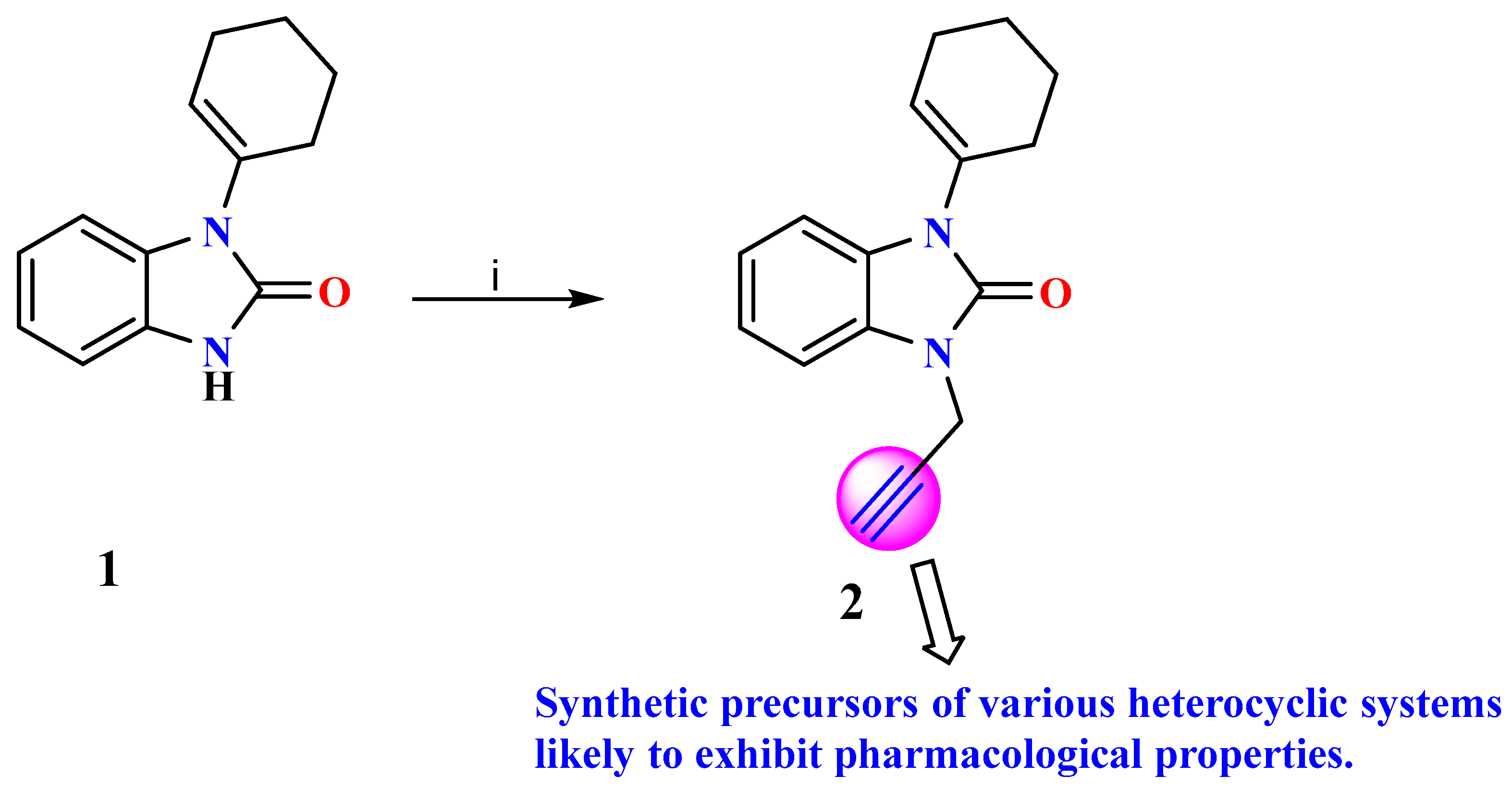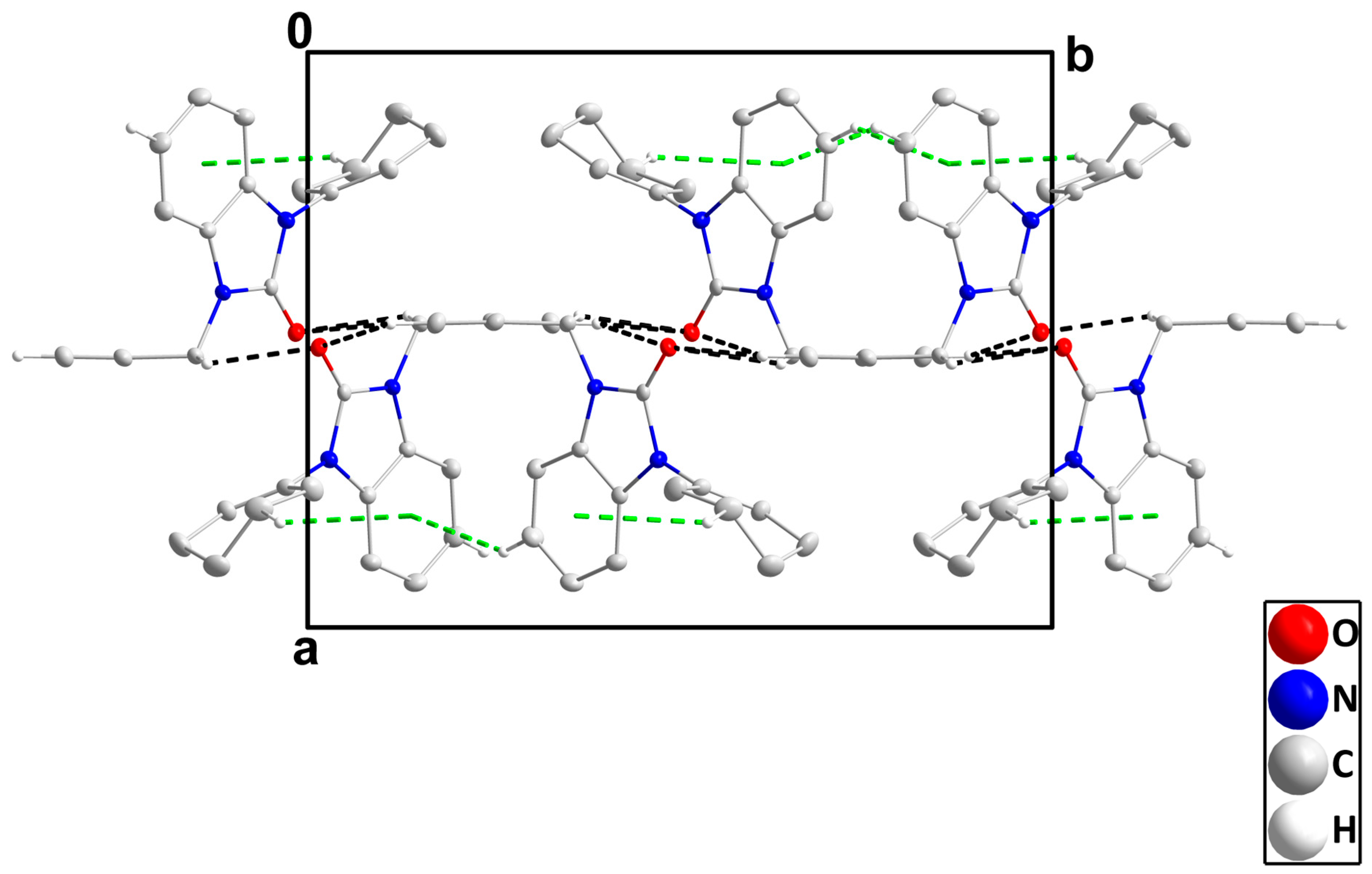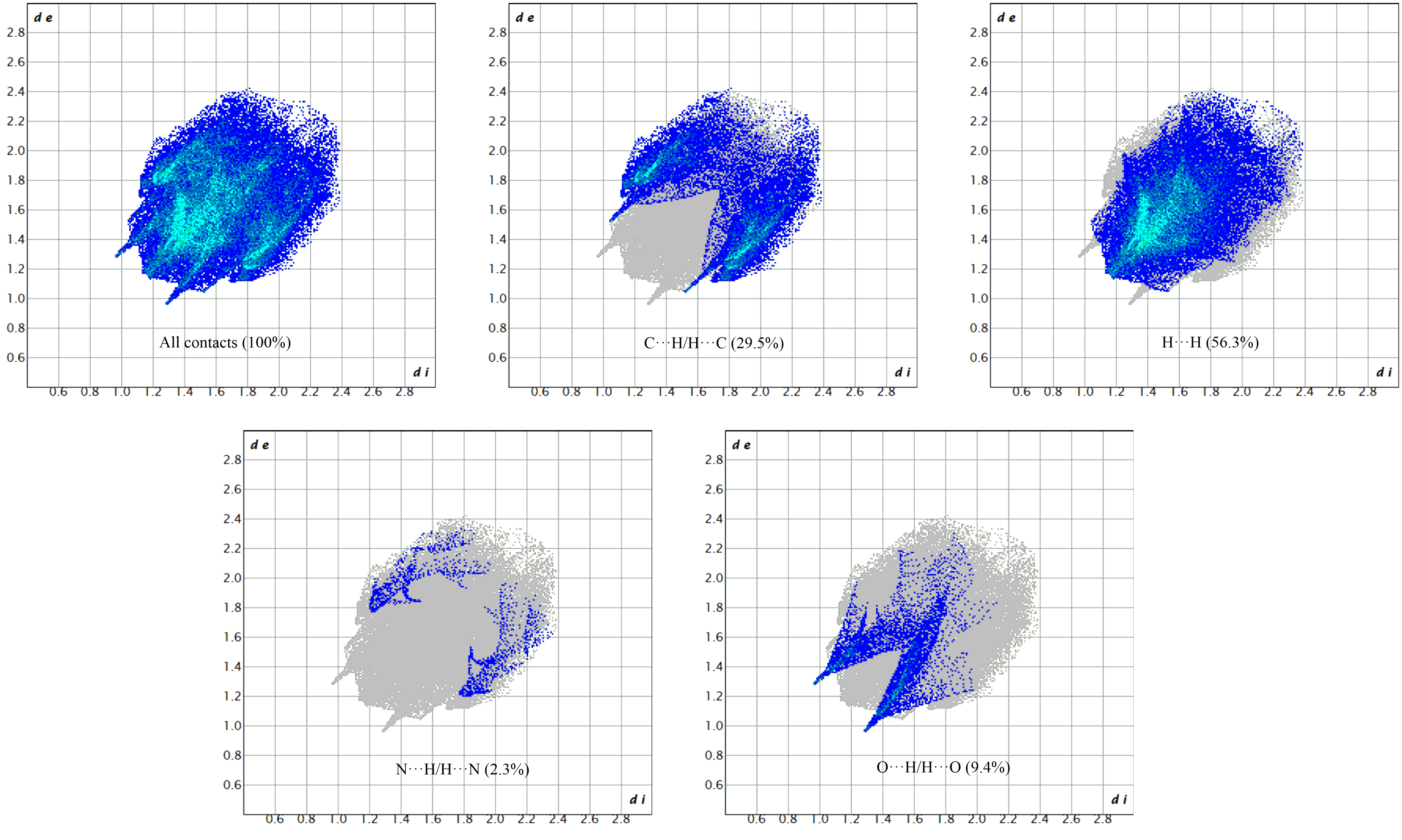Crystal Structure, DFT Calculation, and Hirshfeld Surface Analysis of the 1-(Cyclohex-1-en-1-yl)-3-(prop-2-yn-1-yl)-1,3-dihydro-2H-benzimidazol-2-one
Abstract
:1. Introduction
2. Results and Discussion
2.1. Synthesis and Structural Characterization
2.2. FT-IR Analysis
2.3. X-ray Diffraction and Geometry Optimization
2.4. Hirshfeld Surface Analysis
2.5. Molecular Electrostatic Potential (MEP)
2.6. Pharmacological Analysis
3. Experimental and Computational Methods
3.1. General
3.2. Synthesis of Alkylated Benzimidazolones (2)
Characterization of 1-(Cyclohex-1-en-1-yl)-3-(prop-2-yn-1-yl)-1,3-dihydro-2H-benzimidazol-2-one (2)
3.3. Crystal Structure Determination and Refinement
3.4. DFT Calculations
3.5. Drug-Likeness Prediction
4. Conclusions
Supplementary Materials
Author Contributions
Funding
Institutional Review Board Statement
Informed Consent Statement
Data Availability Statement
Acknowledgments
Conflicts of Interest
References
- Zhang, S.-L.; Damu, G.L.V.; Zhang, L.; Geng, R.-X.; Zhou, C.-H. Synthesis and Biological Evaluation of Novel Benzimidazole Derivatives and Their Binding Behavior with Bovine Serum Albumin. Eur. J. Med. Chem. 2012, 55, 164–175. [Google Scholar] [CrossRef]
- Alpan, A.S.; Parlar, S.; Carlino, L.; Tarikogullari, A.H.; Alptüzün, V.; Güneş, H.S. Synthesis, Biological Activity and Molecular Modeling Studies on 1H-Benzimidazole Derivatives as Acetylcholinesterase Inhibitors. Bioorg. Med. Chem. 2013, 21, 4928–4937. [Google Scholar] [CrossRef] [PubMed]
- Hernández-Luis, F.; Hernández-Campos, A.; Castillo, R.; Navarrete-Vázquez, G.; Soria-Arteche, O.; Hernández-Hernández, M.; Yépez-Mulia, L. Synthesis and Biological Activity of 2-(Trifluoromethyl)-1H-Benzimidazole Derivatives against Some Protozoa and Trichinella Spiralis. Eur. J. Med. Chem. 2010, 45, 3135–3141. [Google Scholar] [CrossRef] [PubMed]
- Mulugeta, E.; Samuel, Y. Synthesis of Benzimidazole-Sulfonyl Derivatives and Their Biological Activities. Biochem. Res. Int. 2022, 2022, 7255299. [Google Scholar] [CrossRef]
- Refaat, H.M. Synthesis and Anticancer Activity of Some Novel 2-Substituted Benzimidazole Derivatives. Eur. J. Med. Chem. 2010, 45, 2949–2956. [Google Scholar] [CrossRef] [PubMed]
- Chandrika, N.T.; Shrestha, S.K.; Ngo, H.X.; Garneau-Tsodikova, S. Synthesis and Investigation of Novel Benzimidazole Derivatives as Antifungal Agents. Bioorg. Med. Chem. 2016, 24, 3680–3686. [Google Scholar] [CrossRef] [PubMed]
- Starčević, K.; Kralj, M.; Ester, K.; Sabol, I.; Grce, M.; Pavelić, K.; Karminski-Zamola, G. Synthesis, Antiviral and Antitumor Activity of 2-Substituted-5-Amidino-Benzimidazoles. Bioorg. Med. Chem. 2007, 15, 4419–4426. [Google Scholar] [CrossRef] [PubMed]
- Tonelli, M.; Simone, M.; Tasso, B.; Novelli, F.; Boido, V.; Sparatore, F.; Paglietti, G.; Pricl, S.; Giliberti, G.; Blois, S.; et al. Antiviral Activity of Benzimidazole Derivatives. II. Antiviral Activity of 2-Phenylbenzimidazole Derivatives. Bioorg. Med. Chem. 2010, 18, 2937–2953. [Google Scholar] [CrossRef]
- Patagar, D.N.; Batakurki, S.R.; Kusanur, R.; Patra, S.M.; Saravanakumar, S.; Ghate, M. Synthesis, Antioxidant and Anti-Diabetic Potential of Novel Benzimidazole Substituted Coumarin-3-Carboxamides. J. Mol. Struct. 2023, 1274, 134589. [Google Scholar] [CrossRef]
- Acar Çevik, U.; Celik, I.; Paşayeva, L.; Fatullayev, H.; Bostancı, H.E.; Özkay, Y.; Kaplancıklı, Z.A. New Benzimidazole-oxadiazole Derivatives: Synthesis, A-glucosidase, A-amylase Activity, and Molecular Modeling Studies as Potential Antidiabetic Agents. Arch. Der Pharm. 2023, 356, 2200663. [Google Scholar] [CrossRef]
- Singh, N.; Pandurangan, A.; Rana, K.; Anand, P.; Ahamad, A.; Tiwari, A.K. Benzimidazole: A Short Review of Their Antimicrobial Activities. Int. Curr. Pharm. J. 2012, 1, 110–118. [Google Scholar] [CrossRef]
- El-Gohary, N.S.; Shaaban, M.I. Synthesis and Biological Evaluation of a New Series of Benzimidazole Derivatives as Antimicrobial, Antiquorum-Sensing and Antitumor Agents. Eur. J. Med. Chem. 2017, 131, 255–262. [Google Scholar] [CrossRef]
- Chen, G.; Liu, Z.; Zhang, Y.; Shan, X.; Jiang, L.; Zhao, Y.; He, W.; Feng, Z.; Yang, S.; Liang, G. Synthesis and Anti-Inflammatory Evaluation of Novel Benzimidazole and Imidazopyridine Derivatives. ACS Med. Chem. Lett. 2013, 4, 69–74. [Google Scholar] [CrossRef] [PubMed]
- Yoon, Y.K.; Ali, M.A.; Wei, A.C.; Choon, T.S.; Osman, H.; Parang, K.; Shirazi, A.N. Synthesis and Evaluation of Novel Benzimidazole Derivatives as Sirtuin Inhibitors with Antitumor Activities. Bioorg. Med. Chem. 2014, 22, 703–710. [Google Scholar] [CrossRef] [PubMed]
- Obot, I.B.; Obi-Egbedi, N.O. Theoretical Study of Benzimidazole and Its Derivatives and Their Potential Activity as Corrosion Inhibitors. Corros. Sci. 2010, 52, 657–660. [Google Scholar] [CrossRef]
- Adardour, M.; Lasri, M.; Ait Lahcen, M.; Maatallah, M.; Idouhli, R.; Alanazi, M.M.; Lahmidi, S.; Abouelfida, A.; Mague, J.T.; Baouid, A. Exploring the Efficacy of Benzimidazolone Derivative as Corrosion Inhibitors for Copper in a 3.5 Wt.% NaCl Solution: A Comprehensive Experimental and Theoretical Investigation. Molecules 2023, 28, 6948. [Google Scholar] [CrossRef]
- Rossi, A.; Hunger, A.; Kebrle, J.; Hoffmann, K. Benzimidazol-Derivate und verwandte Heterocyclen V. Die Kondensation von o-Phenylendiamin mit aliphatischen und alicyclischen β-Ketoestern. Helv. Chim. Acta 1960, 43, 1298–1313. [Google Scholar] [CrossRef]
- Adardour, M.; Zaballos-García, E.; Loughzail, M.; Dahaoui, S.; Baouid, A. Synthesis, Characterization and X-Ray Structure of Heterocyclic Systems Prepared via 1,3-Dipolar Cycloaddition of Nitrile Oxides with Benzimidazolone. J. Mol. Struct. 2018, 1165, 153–161. [Google Scholar] [CrossRef]
- Nath, J.; Paul, R.; Ghosh, S.K.; Paul, J.; Singha, B.; Debnath, N. Drug Repurposing and Relabeling for Cancer Therapy: Emerging Benzimidazole Antihelminthics with Potent Anticancer Effects. Life Sci. 2020, 258, 118189. [Google Scholar] [CrossRef]
- Elhenaw, A.; Al-Wasidi, A.; Refat, M.; Naglah, A. Different Potential Biological Activities of Benzimidazole Derivatives. Egypt. J. Chem. 2021, 64, 3–5. [Google Scholar] [CrossRef]
- Hernández-López, H.; Tejada-Rodríguez, C.J.; Leyva-Ramos, S. A Panoramic Review of Benzimidazole Derivatives and Their Potential BiologicalActivity. Mini Rev. Med. Chem. 2022, 22, 1268–1280. [Google Scholar] [CrossRef] [PubMed]
- Adardour, M.; Boutafda, A.; Hdoufane, I.; Aghraz, A.; Hafidi, M.; Zaballos-García, E.; Cherqaoui, D.; Baouid, A. Efficient and Simple Synthesis of Novel 1,2,3-Triazolyl-Linked Benzimidazolone, Molecular Docking and Evaluation of Their Antimicrobial Activity. Synth. Commun. 2020, 50, 3490–3506. [Google Scholar] [CrossRef]
- Saber, A.; Sebbar, N.K.; Sert, Y.; Alzaqri, N.; Hökelek, T.; El Ghayati, L.; Talbaoui, A.; Mague, J.T.; Baba, Y.F.; Urrutigoîty, M.; et al. Syntheses of N-Substituted Benzimidazolone Derivatives: DFT Calculations, Hirshfeld Surface Analysis, Molecular Docking Studies and Antibacterial Activities. J. Mol. Struct. 2020, 1200, 127174. [Google Scholar] [CrossRef]
- Veena, K.; Raghu, M.S.; Yogesh Kumar, K.; Pradeep Kumar, C.B.; Alharti, F.A.; Prashanth, M.K.; Jeon, B.-H. Design and Synthesis of Novel Benzimidazole Linked Thiazole Derivatives as Promising Inhibitors of Drug-Resistant Tuberculosis. J. Mol. Struct. 2022, 1269, 133822. [Google Scholar] [CrossRef]
- Saber, A.; Anouar, E.H.; Sebbar, G.; Ibrahimi, B.E.; Srhir, M.; Hökelek, T.; Mague, J.T.; Ghayati, L.E.; Sebbar, N.K.; Essassi, E.M. New 1,2,3-Triazole Containing Benzimidazolone Derivatives: Syntheses, Crystal Structures, Spectroscopic Characterizations, Hirshfeld Surface Analyses, DFT Calculations, Anti-Corrosion Property Anticipation, and Antibacterial Activities. J. Mol. Struct. 2021, 1242, 130719. [Google Scholar] [CrossRef]
- Othman, D.I.A.; Hamdi, A.; Tawfik, S.S.; Elgazar, A.A.; Mostafa, A.S. Identification of New Benzimidazole-Triazole Hybrids as Anticancer Agents: Multi-Target Recognition, in Vitro and in Silico Studies. J. Enzym. Inhib. Med. Chem. 2023, 38, 2166037. [Google Scholar] [CrossRef] [PubMed]
- Cremer, D.; Pople, J.A. General Definition of Ring Puckering Coordinates. J. Am. Chem. Soc. 1975, 97, 1354–1358. [Google Scholar] [CrossRef]
- Yang, P.; Zhu, Z.; Chen, M.; Zhou, X.; Chen, W. Microwave-Assisted Synthesis of Polyamine-Functionalized Carbon Dots from Xylan and Their Use for the Detection of Tannic Acid. Spectrochim. Acta Part A Mol. Biomol. Spectrosc. 2019, 213, 301–308. [Google Scholar] [CrossRef]
- Hirshfeld, F.L. Bonded-Atom Fragments for Describing Molecular Charge Densities. Theoret. Chim. Acta 1977, 44, 129–138. [Google Scholar] [CrossRef]
- Spackman, M.A.; McKinnon, J.J.; Jayatilaka, D. Electrostatic Potentials Mapped on Hirshfeld Surfaces Provide Direct Insight into Intermolecular Interactions in Crystals. CrystEngComm 2008, 10, 377–388. [Google Scholar] [CrossRef]
- Spackman, M.A.; Jayatilaka, D. Hirshfeld Surface Analysis. CrystEngComm 2009, 11, 19–32. [Google Scholar] [CrossRef]
- Louroubi, A.; Nayad, A.; Hasnaoui, A.; Hdoufane, I.; Idouhli, R.; Saadi, M.; El Ammari, L.; Abdessalam, A.; Berraho, M.; El Firdoussi, L.; et al. Synthesis, Structural Characterization, Theoretical Studies and Corrosion Inhibition of a New Pyrrole Derivative:1-(1-Benzyl-4-(4-Chlorophenyl)-2,5-Dimethyl-1H-Pyrrol-3-Yl)Ethanone. J. Mol. Struct. 2019, 1189, 240–248. [Google Scholar] [CrossRef]
- Veber, D.F.; Johnson, S.R.; Cheng, H.-Y.; Smith, B.R.; Ward, K.W.; Kopple, K.D. Molecular Properties That Influence the Oral Bioavailability of Drug Candidates. J. Med. Chem. 2002, 45, 2615–2623. [Google Scholar] [CrossRef]
- Egan, W.J.; Merz, K.M.; Baldwin, J.J. Prediction of Drug Absorption Using Multivariate Statistics. J. Med. Chem. 2000, 43, 3867–3877. [Google Scholar] [CrossRef] [PubMed]
- Rutkowska, E.; Pajak, K.; Jóźwiak, K. Lipophilicity--Methods of Determination and Its Role in Medicinal Chemistry. Acta Pol. Pharm. 2013, 70, 3–18. [Google Scholar] [PubMed]
- Chen, C.-P.; Chen, C.-C.; Huang, C.-W.; Chang, Y.-C. Evaluating Molecular Properties Involved in Transport of Small Molecules in Stratum Corneum: A Quantitative Structure-Activity Relationship for Skin Permeability. Molecules 2018, 23, 911. [Google Scholar] [CrossRef]
- Sheldrick, G.M. SHELXT—Integrated Space-Group and Crystal-Structure Determination. Acta Crystallogr. Sect. A. Found. Crystallogr. 2015, 71, 3–8. [Google Scholar] [CrossRef]
- Farrugia, L. WinGX and ORTEP for Windows: An Update. J. Appl. Crystallogr. 2012, 45, 849–854. [Google Scholar] [CrossRef]
- Macrae, C.F.; Edgington, P.R.; McCabe, P.; Pidcock, E.; Shields, G.P.; Taylor, R.; Towler, M.; Van De Streek, J. Mercury: Visualization and Analysis of Crystal Structures. J. Appl. Crystallogr. 2006, 39, 453–457. [Google Scholar] [CrossRef]
- Andersson, M.P.; Uvdal, P. New Scale Factors for Harmonic Vibrational Frequencies Using the B3LYP Density Functional Method with the Triple-ζ Basis Set 6-311+G(d,p). J. Phys. Chem. A 2005, 109, 2937–2941. [Google Scholar] [CrossRef]
- Spackman, P.R.; Turner, M.J.; McKinnon, J.J.; Wolff, S.K.; Grimwood, D.J.; Jayatilaka, D.; Spackman, M.A. CrystalExplorer: A program for Hirshfeld surface analysis, visualization and quantitative analysis of molecular crystals. J. Appl. Cryst. 2021, 54, 1006–1011. [Google Scholar] [CrossRef] [PubMed]
- Daina, A.; Michielin, O.; Zoete, V. SwissADME: A Free Web Tool to Evaluate Pharmacokinetics, Drug-Likeness and Medicinal Chemistry Friendliness of Small Molecules. Sci. Rep. 2017, 7, 42717. [Google Scholar] [CrossRef] [PubMed]
- Lagunin, A.; Zakharov, A.; Filimonov, D.; Poroikov, V. QSAR Modelling of Rat Acute Toxicity on the Basis of PASS Prediction. Mol. Inf. 2011, 30, 241–250. [Google Scholar] [CrossRef] [PubMed]










| Assignments | Experimental | B3LYP/6-311++G(d,p) |
|---|---|---|
| νCH2 | 2930 | 3022 |
| νC-N | 1404 | 1411 |
| νC=O | 1710 | 1771 |
| νC≡C | 2125 | 2223 |
| νC=C (Aromatic) | 1620 | 1648 |
| Empirical Formula | C16H16N2O |
|---|---|
| Crystal system | Monoclinic, |
| Space group | P21/c |
| Temperature (K) | 293 (2) |
| a, b, c (Å) | 11.591 (5), 14.988 (5), 7.570 (5) |
| β (°) | 92.134 (5) |
| V (Å3) | 1314.2 (11) |
| Z | 4 |
| μ (mm−1) | 0.081 |
| Crystal size (mm) | 0.2 × 0.1 × 0.1 |
| Absorption coefficient | 0.081 mm−1 |
| No. of measured, independent, and observed [I > 2σ(I)] reflections | 31,171, 4013, 3287 |
| Rint | 0.0403 |
| (sin θ/λ)max (Å−1) | 0.001 |
| R[F2 > 2σ(F2)], wR(F2), S | 0.04554, 0.1264, 1.056 |
| No. of reflections | 4013 |
| No. of parameters | 185 |
| Largest diff. peak and hole (e Å−3) | 0.440, −0.324 |
| D-H···A | D-H | H···A | D···A | Angle |
|---|---|---|---|---|
| C5-H5‧‧‧Cg2 a,i | 0.93 | 2.93 | 3.746(3) | 147 |
| C12-H12B‧‧‧Cg2 a,ii | 0.97 | 2.78 | 3.576(8) | 140 |
| C14-H14B···O iii | 0.97 | 2.54 | 3.2299(18) | 127.9 |
| C16-H16‧‧‧O1 i | 0.93 | 2.39 | 3.203(3) | 146 |
| Bond Lengths (Å), Bond Angles (°) | Experimental | Calculated DFT/B3LYP/6-311++G(d,p) |
|---|---|---|
| O1-C1 | 1.2237 (14) | 1.222 |
| N1-C1 | 1.3849 (16) | 1.401 |
| N1-C2 | 1.3956 (15) | 1.402 |
| N1-C8 | 1.4362 (16) | 1.431 |
| N2-C1 | 1.3806 (15) | 1.396 |
| N2-C7 | 1.3910 (15) | 1.391 |
| N2-C14 | 1.4541 (15) | 1.431 |
| C1-N1-C2 | 109.85 (10) | 109.59 |
| C1-N1-C8 | 123.81 (10) | 123.50 |
| C2-N1-C8 | 125.88 (10) | 126.90 |
| C1-N2-C7 | 110.49 (10) | 110.51 |
| C1-N2-C14 | 122.77 (10) | 121.66 |
| C7-N2-C14 | 126.69 (10) | 127.77 |
| O-C1-N1 | 126.89 (11) | 127.96 |
| O-C1-N2 | 127.09 (11) | 126.30 |
| N2-C1-N1 | 106.01 (9) | 105.72 |
| C3-C2-N1 | 131.39 (11) | 131.85 |
| N1-C2-C7 | 107.04 (10) | 107.25 |
| N2-C7-C2 | 106.61 (10) | 106.90 |
| C6-C7-N2 | 131.76 (11) | 131.55 |
| C9-C8-N1 | 119.37 (11) | 120.07 |
| N1-C8-C13 | 116.57 (12) | 116.09 |
| N2-C14-C15 | 111.65 (10) | 113.76 |
| Descriptors | |
|---|---|
| EHOMO | −5.8779 eV |
| ELUMO | −0.6057 eV |
| Energy gap (∆E) | 5.2722 eV |
| Ionization potential (I) | 5.8779 eV |
| Electron affinity (EA) | 0.6057 eV |
| Electronegativity (χ) | 2.6361 eV |
| Chemical hardness (η) | 3.2418 eV |
| Drug-Like Parameter | Benzimidazolone (2) |
|---|---|
| Formula | C16H16N2O |
| Molecular weight (g/mol) | 252.31 g/mol |
| H-bond acceptors | 1 |
| H-bond donors | 0 |
| Rotatable bonds | 2 |
| TPSA (Å2) | 26.93 Å2 |
| iLOGP | 3.03 |
| GI absorption | High |
| log Kp (cm/s) | −5.94 cm/s |
| Lipinski violations | Yes * |
| Veber violations | Yes * |
| Egan violations | Yes * |
| Muegge violations | Yes * |
| Bioavailability score | 0.55 |
| LD50 | LD50 (mg/kg) |
|---|---|
| Rat Intraperitoneal (IP) | 317.3 # |
| Rat Intravenous route (IV) | 29.02 * |
| Rat Oral | 1181.00 # |
| Rat Subcutaneous route (SC) | 411.80 # |
Disclaimer/Publisher’s Note: The statements, opinions and data contained in all publications are solely those of the individual author(s) and contributor(s) and not of MDPI and/or the editor(s). MDPI and/or the editor(s) disclaim responsibility for any injury to people or property resulting from any ideas, methods, instructions or products referred to in the content. |
© 2023 by the authors. Licensee MDPI, Basel, Switzerland. This article is an open access article distributed under the terms and conditions of the Creative Commons Attribution (CC BY) license (https://creativecommons.org/licenses/by/4.0/).
Share and Cite
Adardour, M.; Ait Lahcen, M.; Hdoufane, I.; Alanazi, M.M.; Loughzail, M.; Bouzidi Mousser, H.; Fleutot, S.; François, M.; Cherqaoui, D.; Baouid, A. Crystal Structure, DFT Calculation, and Hirshfeld Surface Analysis of the 1-(Cyclohex-1-en-1-yl)-3-(prop-2-yn-1-yl)-1,3-dihydro-2H-benzimidazol-2-one. Crystals 2023, 13, 1661. https://doi.org/10.3390/cryst13121661
Adardour M, Ait Lahcen M, Hdoufane I, Alanazi MM, Loughzail M, Bouzidi Mousser H, Fleutot S, François M, Cherqaoui D, Baouid A. Crystal Structure, DFT Calculation, and Hirshfeld Surface Analysis of the 1-(Cyclohex-1-en-1-yl)-3-(prop-2-yn-1-yl)-1,3-dihydro-2H-benzimidazol-2-one. Crystals. 2023; 13(12):1661. https://doi.org/10.3390/cryst13121661
Chicago/Turabian StyleAdardour, Mohamed, Marouane Ait Lahcen, Ismail Hdoufane, Mohammed M. Alanazi, Mohamed Loughzail, Henia Bouzidi Mousser, Solenne Fleutot, Michel François, Driss Cherqaoui, and Abdesselam Baouid. 2023. "Crystal Structure, DFT Calculation, and Hirshfeld Surface Analysis of the 1-(Cyclohex-1-en-1-yl)-3-(prop-2-yn-1-yl)-1,3-dihydro-2H-benzimidazol-2-one" Crystals 13, no. 12: 1661. https://doi.org/10.3390/cryst13121661
APA StyleAdardour, M., Ait Lahcen, M., Hdoufane, I., Alanazi, M. M., Loughzail, M., Bouzidi Mousser, H., Fleutot, S., François, M., Cherqaoui, D., & Baouid, A. (2023). Crystal Structure, DFT Calculation, and Hirshfeld Surface Analysis of the 1-(Cyclohex-1-en-1-yl)-3-(prop-2-yn-1-yl)-1,3-dihydro-2H-benzimidazol-2-one. Crystals, 13(12), 1661. https://doi.org/10.3390/cryst13121661











